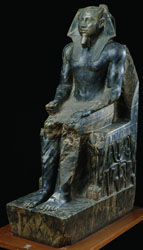Post and Lintel- the simple and very ancient system of construction in which the basic unit consists of two or more uprights, or "posts," supporting a horizontal beam, or "lintel". Across two lintels liad parallel to each other, other lintels may be laid at right angles to support a roof or ceiling. When stone lintels are used, however, the supports must be close together because of the brittleness of the stone.
Axis- an imaginary line passing through a figure, building,
etc. about which the principal parts are arranged. Bilateral symmetry
pertains to where the elements on either side of an axis are symmetrical.
A Nova show on PBS exploring the pyramids has a useful web-site associated with it . I recommend exploring this site.

|

|
| Pyramid Complex of King Khafre (Chephren), 2500. | Statue of King Khafre (Chephren), c. 2500. |
The function of a work of art or architecture often determines its form. In the case of these two monuments the functions can be defined as their roles in the cult of the dead. Define the functions of these monuments and demonstrate how their functions have determined their forms. Also try to define what you consider to be the underlying essential Egyptian elements of both.